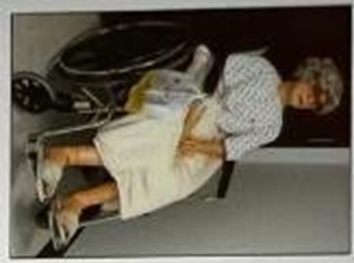The nurse enters the room of an older adult client and observes the client positioned in a wheelchair as seen in the picture. The unlicensed assistive personnel (UAP) is preparing to push the client's wheelchair in the hallway. Which instruction should the nurse provide the UAP before the client is moved into the hallway?

Use a belt restraint to secure the client in the chair.
Empty the client's urinary drainage bag.
Reposition the client's urinary drainage bag.
Elevate the client's feet higher on the foot rests.
The Correct Answer is C
A. Using a belt restraint is generally not recommended unless specifically ordered for safety reasons, as it may not be appropriate or necessary in all cases. Restraints should only be used when absolutely needed and when all other methods of ensuring safety have been considered.
B. Emptying the urinary drainage bag before moving the client is important to prevent overflows and ensure that the bag does not become a source of discomfort or potential infection. However, this step might not always be immediately necessary unless the bag is full or the client’s comfort and hygiene are at risk.
C. Repositioning the urinary drainage bag is crucial for ensuring that the bag remains below the level of the bladder and is not subject to kinks or obstructions. This helps prevent backflow and potential infections. Proper positioning also contributes to the client’s comfort and dignity, making this a priority before moving the client.
D. Elevating the client’s feet on the footrests is important for their comfort and to prevent swelling or pressure sores, especially if the client has limited mobility or circulatory issues. Proper positioning can prevent discomfort and promote better circulation, which is essential for maintaining the client’s well- being during transport.
Nursing Test Bank
Naxlex Comprehensive Predictor Exams
Related Questions
Correct Answer is C
Explanation
A. While assessing brain stem reflexes can provide valuable information about the neurological status of the client, it is not the immediate priority when preparing to move a client from bed to a chair. Brain stem reflexes are more relevant for assessing overall neurological function and response to stimuli, but they do not directly inform the safety and readiness of the client for physical activity.
B. Assessing the pupillary response is important for evaluating neurological function and consciousness levels. However, it is not directly related to assessing the client’s readiness to be moved from bed to a chair. Pupillary response does not provide specific information about the client’s hemodynamic stability or immediate readiness for physical activity.
C. Assessing the client’s blood pressure is crucial, especially after a stroke, as the client may be at risk for orthostatic hypotension (a sudden drop in blood pressure when standing up). Checking blood pressure helps ensure that the client is hemodynamically stable and can tolerate the change in position without risking dizziness, fainting, or other complications.
D. Offering the client the opportunity to void before getting out of bed is a practical measure to ensure comfort and avoid accidents. It helps prevent the need for the client to seek the bathroom immediately after being moved to the chair, which could be disorienting or potentially hazardous.
Correct Answer is B
Explanation
A. While providing practical advice is useful, this response does not directly address the client's current emotional state or frustration. The immediate need is to support the client emotionally rather than instructing them on dressing techniques. It may also come off as dismissive of the client’s feelings.
B. This response is the most appropriate because it acknowledges and validates the client’s emotional experience. By recognizing their frustration, the nurse shows empathy and understanding, which can help in building a therapeutic relationship. It also opens up a dialogue for the client to express their feelings and concerns, which can improve their overall comfort and cooperation.
C. While education on dressing techniques is beneficial, this response does not address the client's immediate frustration or emotional needs. It also postpones support and could make the client feel like their current struggles are not being adequately addressed in the moment.
D. This response is defensive and does not address the client’s immediate emotional needs. It may escalate the situation by making the client feel like they are being reprimanded for their behavior. It is important to handle such situations with empathy and support rather than focusing on institutional policies.
Whether you are a student looking to ace your exams or a practicing nurse seeking to enhance your expertise , our nursing education contents will empower you with the confidence and competence to make a difference in the lives of patients and become a respected leader in the healthcare field.
Visit Naxlex, invest in your future and unlock endless possibilities with our unparalleled nursing education contents today
Report Wrong Answer on the Current Question
Do you disagree with the answer? If yes, what is your expected answer? Explain.
Kindly be descriptive with the issue you are facing.
